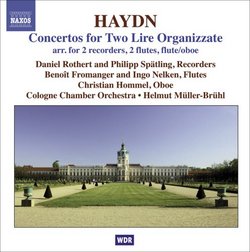| All Artists: Hommel, Daniel Rothert, Philipp Spatling, Benoit Frommanger, Ingo Nelken Title: Haydn: Concertos for Two Lire Organizzate Members Wishing: 0 Total Copies: 0 Label: Naxos Original Release Date: 1/1/2008 Re-Release Date: 1/27/2009 Genre: Classical Styles: Chamber Music, Forms & Genres, Concertos, Historical Periods, Classical (c.1770-1830) Number of Discs: 1 SwapaCD Credits: 1 UPC: 747313048175 |
Search - Hommel, Daniel Rothert, Philipp Spatling :: Haydn: Concertos for Two Lire Organizzate
 | Hommel, Daniel Rothert, Philipp Spatling Haydn: Concertos for Two Lire Organizzate Genre: Classical |
Larger Image |
CD Details |
CD ReviewsHaydn for Lire Organizzate Robin Friedman | Washington, D.C. United States | 08/14/2009 (4 out of 5 stars) "In 1785 - 1786, at the time he was composing the "Paris" Symphonies, Haydn received a commission from King Ferdinand IV of Naples to write a set of six concertos for two lire organizzate. (The "e" at the end gives the plural form.) The lire organizzata was a peculiar mechanical instrument of the day played like the hurdy-gurdy by turning a crank. It had a wheel, strings, and small keyboard with a range and sound similar to the oboe. Because the instrument included pipes, it was capable of doubling the sound, both by producing the same note at a different timbre, or by doubling the note at the octave. The lire organizzata could play only in the keys of C, G, and F. This limitation, of course, greatly restricted the type and complexity of the music that it could perform.
Haydn wrote these works for King Ferdinand and his music teacher to perform on the lire. The works were scored for a small orchestra consisting of two horns, two violins, two violas, and a cello. The music is of no great complexity but it is appealing. One of the six concertos has been lost. The remaining five of these unusual works are included in this recording by the Cologne Chamber Orchestra conducted by Helmut Muller-Bruhl on the budget-priced Naxos label. Muller-Bruhl and his orchestra have recorded seven volumes of Haydn symphonies for Naxos as part of that label's complete cycle of the Haydn symphonies together with a six-volume compilation of the complete Haydn concertos. This CD of lire concertos was released in January 2009 and is available individually or as part of the six-CD compilation. It would be intriguing to find these works played on the lire organizzate for which they were written. Alas, that instrument appears to be no more. Haydn himself transferred the parts to other instruments for performance at Esterhaza. We are fortunate to have these works performed here for combinations of wind instruments as soloists, including two recorders in concertos 1 and 5, flute and oboe in concertos 2 and 4, and two flutes in concerto 3. The small orchestra performs on modern instruments using historical performance practices. The works are in a concertante style. Rather than beginning with a lengthy orchestral introduction followed by passages highlighting the solo instrument, as in subsequent concertos, the orchestra and the soloist generally follow each other in short phrases. The two solo instruments generally play together, often in unison. The two solo instruments sometimes play separately. When they do, each instrument takes a short phrase which is repeated or varied slightly by the other soloist. Each of these five concertos is in three movements, with an opening allegro, a florid, vocal-like slow movement, and a sprightly conclusion. Several of the works feature cadenzas and in one work, the concluding allegro includes a slower middle section. Listeners familiar with Haydn may recognize much of the music of these pieces. As with virtually every prolific composer, Haydn both recycled works from earlier scores into these concertos and used music he created here in subsequent works. The most recognizable example of the latter is in the concerto no. 3 in G major, performed here by two flutes. Many listeners will recognize the second movement of this work, because Haydn used it to great effect in the slow movement of his Symphony No. 100, the "Military" Symphony. The informative program notes for this CD point out that Haydn borrowed from an earlier opera aria he had composed in the slow movement for the concerto no. 2 in G major performed here by flute and oboe. The final concerto we have, no 5 in F major performed by two recorders, borrows from Haydn's symphony no 13 (which includes the theme Mozart used in the finale of his "Jupiter" symphony) in the first movement and uses material that Haydn would use in his nearly-contemporaneous symphony no. 89 in the second and third movements. Although not mentioned in the program notes, the jocular finale to the concerto no. 4 in F major, performed by flute and oboe, was familiar to me and derived from a Haydn symphony that I could not place. Undoubtedly, there were other borrowings as well. These concertos are delightful and rarely performed on any instruments, not to speak of on two lire organizzate. Lovers of Haydn and of early classical music will enjoy getting to know these works in commemoration of the 200th anniversary (1732 - 1809) of this great composer's death. Robin Friedman" |
